| Look up teletype in Wiktionary, the free dictionary. |
The teletype, or teleprinter, is a device used for communicating text over telegraph lines, public switched telephone network, Telex, radio, or satellite links.
Teletype may also refer to:
| Look up teletype in Wiktionary, the free dictionary. |
The teletype, or teleprinter, is a device used for communicating text over telegraph lines, public switched telephone network, Telex, radio, or satellite links.
Teletype may also refer to:
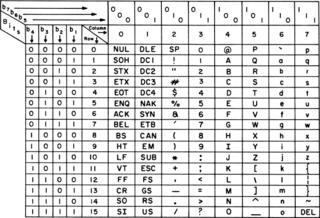
ASCII, abbreviated from American Standard Code for Information Interchange, is a character encoding standard for electronic communication. ASCII codes represent text in computers, telecommunications equipment, and other devices. Most modern character-encoding schemes are based on ASCII, although they support many additional characters.

The Baudot code[boˈdo] is an early character encoding for telegraphy invented by Émile Baudot in the 1870s. It was the predecessor to the International Telegraph Alphabet No. 2 (ITA2), the most common teleprinter code in use until the advent of ASCII. Each character in the alphabet is represented by a series of five bits, sent over a communication channel such as a telegraph wire or a radio signal. The symbol rate measurement is known as baud, and is derived from the same name.

An electrical telegraph is a point-to-point text messaging system, primarily used from the 1840s until the mid 20th century when it was slowly replaced by other telecommunication systems. It used coded pulses of electric current through dedicated wires to transmit information over long distances. It was the first electrical telecommunications system, the most widely used of a number of early messaging systems called telegraphs, devised to send text messages more rapidly than written messages could be sent. This system allowed for communication to occur without the necessity of physical transportation. Prior to the electric telegraph, semaphore systems were used, including beacons, smoke signals, flag semaphore, and optical telegraphs for visual signals to communicate over distances of land.
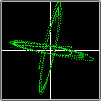
Radioteletype (RTTY) is a telecommunications system consisting originally of two or more electromechanical teleprinters in different locations connected by radio rather than a wired link. These machines were superseded by personal computers (PCs) running software to emulate teleprinters. Radioteletype evolved from earlier landline teleprinter operations that began in the mid-1800s. The US Navy Department successfully tested printing telegraphy between an airplane and ground radio station in 1922. Later that year, the Radio Corporation of America successfully tested printing telegraphy via their Chatham, Massachusetts, radio station to the R.M.S. Majestic. Commercial RTTY systems were in active service between San Francisco and Honolulu as early as April 1932 and between San Francisco and New York City by 1934. The US military used radioteletype in the 1930s and expanded this usage during World War II. From the 1980s, teleprinters were replaced by computers running teleprinter emulation software.

A telephone is a telecommunications device that permits two or more users to conduct a conversation when they are too far apart to be heard directly. A telephone converts sound, typically and most efficiently the human voice, into electronic signals that are transmitted via cables and other communication channels to another telephone which reproduces the sound to the receiving user. The term is derived from Greek: τῆλε and φωνή, together meaning distant voice. A common short form of the term is phone, which came into use almost immediately after the first patent was issued.
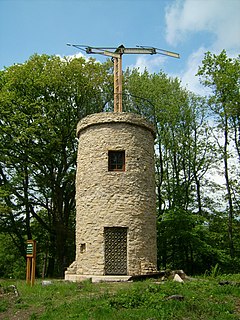
Telegraphy is the long-distance transmission of textual messages where the sender uses a system, known to the recipient, rather than a physical exchange of an object bearing the message. Thus flag semaphore is a method of telegraphy, whereas pigeon post is not. Ancient signalling systems, although sometimes quite extensive and sophisticated as in China, were generally not capable of transmitting arbitrary text messages. Possible messages were fixed and predetermined and such systems are thus not true telegraphs.

A teleprinter is an electromechanical device that can be used to send and receive typed messages through various communications channels, in both point-to-point and point-to-multipoint configurations. Initially they were used in telegraphy, which developed in the late 1830s and 1840s as the first use of electrical engineering, though teleprinters were not used for telegraphy until 1887 at the earliest. The machines were adapted to provide a user interface to early mainframe computers and minicomputers, sending typed data to the computer and printing the response. Some models could also be used to create punched tape for data storage and to read back such tape for local printing or transmission.
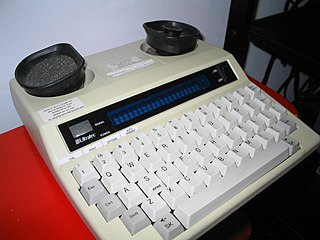
A telecommunications device for the deaf (TDD) is a teleprinter, an electronic device for text communication over a telephone line, that is designed for use by persons with hearing or speech difficulties. Other names for the device include teletypewriter (TTY), textphone, and minicom.

The Teletype Model 33 is an electromechanical teleprinter designed for light-duty office use. It is less rugged and cost less than earlier Teletype machines. The Teletype Corporation introduced the Model 33 as a commercial product in 1963 after being originally designed for the United States Navy. There are three versions of the Model 33:

The history of telecommunication began with the use of smoke signals and drums in Africa, Asia, and the Americas. In the 1790s, the first fixed semaphore systems emerged in Europe. However, it was not until the 1830s that electrical telecommunication systems started to appear. This article details the history of telecommunication and the individuals who helped make telecommunication systems what they are today. The history of telecommunication is an important part of the larger history of communication.

The Moscow–Washington hotline is a system that allows direct communication between the leaders of the United States and the Russian Federation. This hotline was established in 1963 and links the Pentagon with the Kremlin. Although in popular culture it is known as the "red telephone", the hotline was never a telephone line, and no red phones were used. The first implementation used Teletype equipment, and shifted to fax machines in 1986. Since 2008, the Moscow–Washington hotline has been a secure computer link over which messages are exchanged by a secure form of email.

Post Office Telecommunications was set up as a separate department of the UK Post Office, in October 1969. The Post Office Act 1969 was passed to provide for greater efficiency in post and telephone services; rather than run a range of services, each organisation would be able to focus on their respective service, with dedicated management. By law, the Post Office had the exclusive right to operate the UK national telecom network, and limited ability to license other providers' services and equipment. The National Telephone Company controlled most of telephony in Britain before the 1880 ruling on the Telegraph Act 1869 mandated a nationalised service – which was instated in 1911. The 1869 Telegraph Act granted this monopoly over communications and it was confirmed in 1880 that this Act included telephony even though the telephone had not been invented when the Act was first conceived. Post Office engineers in the inter-war period had considerable expertise in both telecommunications and hearing assistive devices.
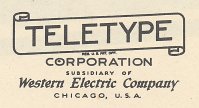
The Teletype Corporation, a part of American Telephone and Telegraph Company's Western Electric manufacturing arm since 1930, came into being in 1928 when the Morkrum-Kleinschmidt Company changed its name to the name of its trademark equipment. Teletype Corporation, of Skokie, Illinois, was responsible for the research, development and manufacture of data and record communications equipment, but it is primarily remembered for the manufacture of electromechanical teleprinters.

This history of the telephone chronicles the development of the electrical telephone, and includes a brief review of its predecessors.
Edward Ernst Kleinschmidt was one of the inventors of the teleprinter, and was a prolific inventor who obtained 118 patents in the course of his 101-year life.
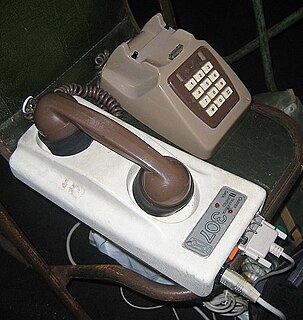
A modulator-demodulator, or simply a modem, is a hardware device that converts data from a digital format, intended for communication directly between devices with specialized wiring, into one suitable for a transmission medium such as telephone lines or radio. A modem modulates one or more carrier wave signals to encode digital information for transmission, and demodulates signals to decode the transmitted information. The goal is to produce a signal that can be transmitted easily and decoded reliably to reproduce the original digital data.
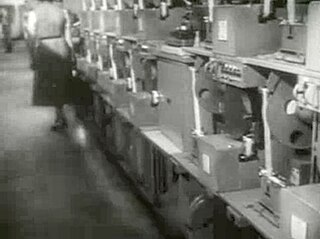
Plan 55-A was one in a series of store and forward message switching systems developed by Western Union and used from 1948 to 1976 for processing telegrams. It is an automated successor to Plan 51, which commenced service in 1951 in a nationwide network of the U.S. Air Force, but required semi-automatic operation.
Telecommunications equipment is a hardware which is used for the purposes of telecommunications. Since the 1990s the boundary between telecoms equipment and IT hardware has become blurred as a result of the growth of the internet and its increasing role in the transfer of telecoms data.
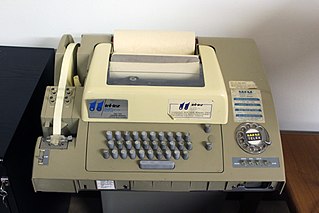
The telex network was a customer-to-customer switched network of teleprinters similar to a telephone network, using telegraph-grade connecting circuits for two-way text-based messages. Telex was a major method of sending written messages electronically between businesses in the post-World War II period. Its usage went into decline as the fax machine grew in popularity in the 1980s.

Donald Murray was an electrical engineer and the inventor of a telegraphic typewriter system using an extended Baudot code that was a direct ancestor of the teleprinter. He can justifiably be called the "Father of the remote Typewriter".